Comparison of Pulse-Echo Tomography and Through-Transmission Ultrasonic Test for UPV Characterization of Building Materials
Abstract
1. Introduction
2. Materials and Methods
2.1. Materials
2.2. Through-Transmission Ultrasonic Tests
2.3. Pulse Echo Tomography
2.4. Specimen Dimensions and Testing Program
3. Results and Discussion
3.1. Through-Transmission Ultrasonic Tests
3.1.1. Direct Transmission Mode
3.1.2. Indirect Transmission Mode
3.1.3. Comparison Between Indirect and Direct Transmission Mode Results
3.2. Pulse Echo Tomography Test Results
Comparison Between Pulse-Echo and Through-Transmission Ultrasonic Test Results
4. Conclusions
- Exponential transducer results were less affected by water and surface roughness than the cylindrical transducer in direct transmission mode. On the other hand, the lower power of the signal due to the presence of the exponential tip caused measurement uncertainty, especially in concrete. Differences between UPV of exponential and cylindrical transducers were higher in concrete (4.4%) than in stone (2.6%).
- In the case of indirect measurements, exponential transducers experienced higher attenuation of the signal over higher distances than cylindrical ones. Thus, differences between the time means of the two transducers increased at higher path lengths, causing a lower indirect UPV value for exponential transducers than cylindrical ones (differences in results of 24% and 22% for stone and concrete, respectively).
- By comparing the results of UPV measured by direct and indirect transmission modes, it was found that exponential transducers gave unreliable results in the indirect mode independently of the material tested. Indeed, differences between 23% and 29% were found between the results of the two measurement modes.
- The superficial velocities were lower than those obtained by the calibration mode for both concrete and stone specimens.
- The differences between the UPV values obtained by the two calibration modes were within the measurement variability.
- The presence of water increased the S-wave velocities in concrete, but less than the P-wave velocities. The superficial velocity of the concrete blocks in saturated conditions was still lower than the Cal 1 and Cal 2 results.
- In the case of Lecce stone in saturated conditions, the instrument did not measure superficial velocity because its value was below the full scale of the instrument. Furthermore, only one backwall was visible in the tomographic image. Thus, only the calibration 1 result was available, and its value was lower than in dry conditions, following the P-wave results.
- Cal 2 mode velocities better fit than Cal 1 mode the direct transmission results of concrete with and without water. Furthermore, superficial wave results followed those of the 54 kHz indirect measurement.
- In the case of stone in ambient conditions, the Cal 2 results fit better than Cal 1 with the results of the direct transmission mode. Superficial mode results differed from the indirect transmission ones of unacceptable values for both transducers. Probably, the superficial mode was inaccurate in the case of Lecce stone due to velocity values near the full scale of the instrument. The results in the presence of water were comparable to TT-UT in direct mode.
- Exponential transducer results in indirect transmission mode significantly differed from the superficial P-wave velocities obtained with the pulse-echo instrument. The results confirmed the previous conclusions on indirect mode results using these transducers.
Author Contributions
Funding
Data Availability Statement
Conflicts of Interest
List of Abbreviations
| UPV | Ultrasonic Pulse Velocity |
| PE-UT | Pulse Echo Ultrasonic Tomography |
| TT-UT | Through Transmission Ultrasonic Test |
| Δ (cyl-exp) | difference between the UPV values of cylindrical and exponential transducers |
| Vp | P-wave velocity |
| Vs | S-wave velocities |
| Vp_cal1 | PE-UT P-wave velocity results from calibration 1 measurements |
| Vp cal2 | PE-UT P-wave velocity results from calibration 2 measurements |
| Vp sup | PE-UT P-wave velocity results from superficial measurements |
References
- McCann, D.; Forde, M. Review of NDT methods in the assessment of concrete and masonry structures. NDT & E Int. 2001, 34, 71–84. [Google Scholar] [CrossRef]
- Vasanelli, E.; Colangiuli, D.; Calia, A.; Sileo, M.; Aiello, M.A. Ultrasonic pulse velocity for the evaluation of physical and mechanical properties of a highly porous building limestone. Ultrasonics 2015, 60, 33–40. [Google Scholar] [CrossRef]
- Breysse, D.; Balayssac, J.-P.; Alwash, M.; Biondi, S.; Chiauzzi, L.; Corbett, D.; Garnier, V.; Gonçalves, A.; Grantham, M.; Gunes, O.; et al. In-situ strength assessment of concrete: Detailed guidelines. In Non-Destructive In Situ Strength Assessment of Concrete: Practical Application of the RILEM TC 249-ISC Recommendations; Springer: Cham, Switzerland, 2021; pp. 3–56. [Google Scholar] [CrossRef]
- Saleem, M.; Gutierrez, H. Using artificial neural network and non-destructive test for crack detection in concrete surrounding the embedded steel reinforcement. Struct. Concr. 2021, 22, 2849–2867. [Google Scholar] [CrossRef]
- Karaiskos, G.; Deraemaeker, A.; Aggelis, D.G.; Van Hemelrijck, D. Monitoring of concrete structures using the ultrasonic pulse velocity method. Smart Mater. Struct. 2015, 24, 113001. [Google Scholar] [CrossRef]
- Lee, J.H.; Park, W.S.; Popovics, J.S.; Achenbach, J.D. Application of one-sided stress wave velocity measurement technique to evaluate freeze-thaw damage in concrete. Rev. Prog. Quant. Nondestruct. Eval. 1999, 18A–18B, 1935–1942. [Google Scholar]
- Yaman, I.O.; Inci, G.; Yesiller, N.; Aktan, H.M. Ultrasonic pulse velocity in concrete using direct and indirect transmission. ACI Mater. J. 2001, 98, 450. [Google Scholar]
- Malhotra, V.M.; Carino, N.J. Handbook on Nondestructive Testing of Concrete; CRC Press: Boca Raton, FL, USA, 2003. [Google Scholar]
- Turgut, P.; Kucuk, O.F. Comparative relationships of direct, indirect, and semi-direct ultrasonic pulse velocity measurements in concrete. Russ. J. Nondestruct. Test. 2006, 42, 745–751. [Google Scholar] [CrossRef]
- Biondi, S.; Valente, C.; Zuccarino, L. Concrete Strength Evaluation through indirect UPV. In Proceedings of the Concrete Solutions, 5th International Conference on Concrete Repair, Belfast, UK, 1–3 September 2014; pp. 771–778. [Google Scholar] [CrossRef]
- Lee, C.H.; Jo, Y.H. Correlation and correction factor between direct and indirect methods for the ultrasonic measurement of stone samples. Environ. Earth Sci. 2017, 76, 477. [Google Scholar] [CrossRef]
- Chai, H.K.; Momoki, S.; Kobayashi, Y.; Aggelis, D.G.; Shiotani, T. Tomographic reconstruction for concrete using attenuation of ultrasound. NDT & E Int. 2011, 44, 206–215. [Google Scholar] [CrossRef]
- Silva, F.A.; Nogueira, C.L.; Silva, J.A.; Araújo, A.V.; Azevedo, A.C.; Delgado, J.M. Ultrasonic assessment of damage in concrete under compressive and thermal loading using longitudinal and transverse waves. Russ. J. Nondestruct. Test. 2019, 55, 808–816. [Google Scholar] [CrossRef]
- De La Haza, A.O.; Samokrutov, A.A.; Samokrutov, P.A. Assessment of concrete structures using the Mira and Eyecon ultrasonic shear wave devices and the SAFT-C image reconstruction technique. Constr. Build. Mater. 2013, 38, 1276–1291. [Google Scholar] [CrossRef]
- Wang, Q.; Chen, D.; Zhu, K.; Zhai, Z.; Xu, J.; Wu, L.; Hu, D.; Xu, W.; Huang, H. Evaluation Residual Compressive Strength of Tunnel Lining Concrete Structure after Fire Damage Based on Ultrasonic Pulse Velocity and Shear-Wave Tomography. Processes 2022, 10, 560. [Google Scholar] [CrossRef]
- Kwon, H.; Joh, C.; Chin, W.J. 3D Internal Visualization of Concrete Structure Using Multifaceted Data for Ultrasonic Array Pulse-Echo Tomography. Sensors 2021, 21, 6681. [Google Scholar] [CrossRef]
- Ivanchev, I. Experimental determination of dynamic modulus of elasticity of concrete with ultrasonic pulse velocity method and ultrasonic pulse echo method. IOP Conf. Ser. Mater. Sci. Eng. 2022, 1252, 012018. [Google Scholar] [CrossRef]
- Felicetti, R. Assessment of a fire-damaged concrete overpass: The Verona bus crash case study. J. Struct. Fire Eng. 2022, 13, 293–306. [Google Scholar] [CrossRef]
- Abreu Filho, M.A.; Moreno, C.; Luso, E. The Use of Ultrasonic Echo Pulse Velocity as an NDT Method to Predict the Concrete Strength and Uniformity. Russ. J. Nondestruct. Test. 2022, 58, 277–288. [Google Scholar] [CrossRef]
- Gudra, T.; Stawiski, B. Non-destructive strength characterization of concrete using surface waves. NDT & E Int. 2000, 33, 1–6. [Google Scholar] [CrossRef]
- Stawiski, B.; Kania, T. Tests of Concrete Strength across the Thickness of Industrial Floor Using the Ultrasonic Method with Exponential Spot Heads. Materials 2020, 13, 2118. [Google Scholar] [CrossRef]
- Hager, I.; Carré, H.; Krzemień, K. Damage assessment of concrete subjected to high temperature by means of the ultrasonic pulse velocity–UPV method. Stud. Res. 2013, 32, 197–211. [Google Scholar]
- UNI EN 197-1:2011; Cement—Part 1: Composition, Specifications and Conformity Criteria for Common Cements. European Committee for Standardization: Brussels, Belgium, 2011.
- UNI EN 12390-3:2019; Testing Hardened Concrete—Part 3: Compressive Strength of Test Specimens. European Committee for Standardization: Brussels, Belgium, 2019.
- Calia, A.; Tabasso, M.L.; Mecchi, A.M.; Quarta, G. The study of stone for conservation purposes: Lecce stone (southern Italy). Geol. Soc. Lond. Spéc. Publ. 2014, 391, 139–156. [Google Scholar] [CrossRef]
- UNI EN 12504-4:2005; Testing Concrete—Part 4: Determination of Ultrasonic Pulse Velocity. European Committee for Standardization: Brussels, Belgium, 2005.
- Schickert, M.; Krause, M.; Müller, W. Ultrasonic Imaging of Concrete Elements Using Reconstruction by Synthetic Aperture Focusing Technique. J. Mater. Civ. Eng. 2003, 15, 235–246. [Google Scholar] [CrossRef]
- Candelaria, M.D.E.; Kee, S.-H.; Yee, J.-J.; Lee, J.-W. Effects of Saturation Levels on the Ultrasonic Pulse Velocities and Mechanical Properties of Concrete. Materials 2020, 14, 152. [Google Scholar] [CrossRef] [PubMed]
- Yaman, I.O.; Hearn, N.; Aktan, H.M. Active and non-active porosity in concrete Part I: Experimental evidence. Mater. Struct. 2002, 35, 102–109. [Google Scholar] [CrossRef]
- Güneyli, H.; Karahan, S.; Güneyli, A.; Yapιcι, N. Water content and temperature effect on ultrasonic pulse velocity of concrete. Russ. J. Nondestruct. Test. 2017, 53, 159–166. [Google Scholar] [CrossRef]
- Godinho, J.P.; Júnior, T.F.D.S.; Medeiros, M.H.F.; Silva, M.A. Factors influencing ultrasonic pulse velocity in concrete. Rev. IBRACON Estruturas Mater. 2020, 13, 222–247. [Google Scholar] [CrossRef]
- Basma, A.A.; Al-Homoud, A.S.; Malkawi, A.I.H.; Al-Bashabsheh, M.A. Swelling-shrinkage behavior of natural expansive clays. Appl. Clay Sci. 1996, 11, 211–227. [Google Scholar] [CrossRef]
- Karakul, H.; Ulusay, R. Empirical Correlations for Predicting Strength Properties of Rocks from P-Wave Velocity Under Different Degrees of Saturation. Rock Mech. Rock Eng. 2013, 46, 981–999. [Google Scholar] [CrossRef]
- Pal, P. Dynamic poisson’s ratio and modulus of elasticity of pozzolana Portland cement concrete. Int. J. Eng. Technol. Innov. 2019, 9, 131–144. [Google Scholar]
- Shen, S.; Gao, Y.; Jia, L. A Comparison of the Relationship between Dynamic and Static Rock Mechanical Parameters. Appl. Sci. 2024, 14, 4487. [Google Scholar] [CrossRef]
- Popovics, S. Verification of relationships between mechanical properties of concrete-like materials. Mat. Constr. 1975, 8, 183–191. [Google Scholar] [CrossRef]
- Andayani, S.W.; Suratman, R.; Imran, I. Mardiyati Polymer Modified Concrete of Blended Cement and Natural Latex Copolymer: Static and Dynamic Analysis. Open J. Civ. Eng. 2018, 8, 205–220. [Google Scholar] [CrossRef]
- Anson, M.; Newman, K. The effect of mix proportions and method of testing on Poisson’s ratio for mortars and concretes. Mag. Concr. Res. 1966, 18, 115–130. [Google Scholar] [CrossRef]
- Model Code 2010-First Complete Draft-Volume 2: Model Code; FIB (Fédération Internationale du Béton): Lausanne, Switzerland, 2010.
- Swamy, R.N. Dynamic Poisson’s ratio of portland cement paste, mortar and concrete. Cem. Concr. Res. 1971, 1, 559–583. [Google Scholar] [CrossRef]
- Ahmed, L. Dynamic Measurements for Determining Poisson’s Ratio of Young Concrete. Nord. Concr. Res. 2018, 58, 95–106. [Google Scholar] [CrossRef]
- Sileo, M. Individuazione e Caratterizzazione Geologica, Chimico-Mineralogica e Petrofisica di Calcareniti Tenere della Puglia e della Basilicata in Relazione alle Problematiche di Provenienza e Conservazione dei Beni Culturali; Basilicata University–IBAM (Institute of Archaeological and Monumental Heritage), CNR: Matera, Italy, 2012. (In Italian) [Google Scholar]

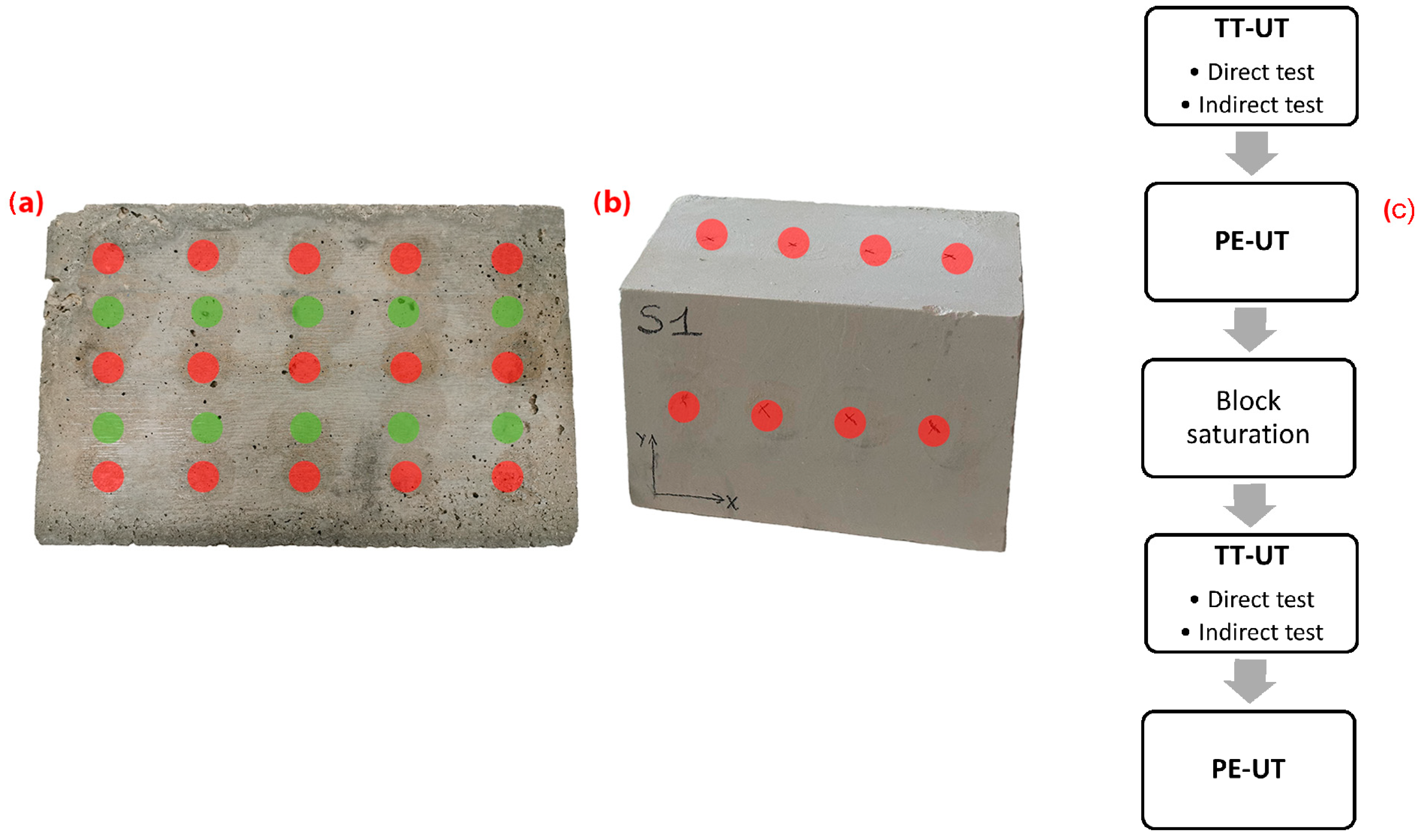

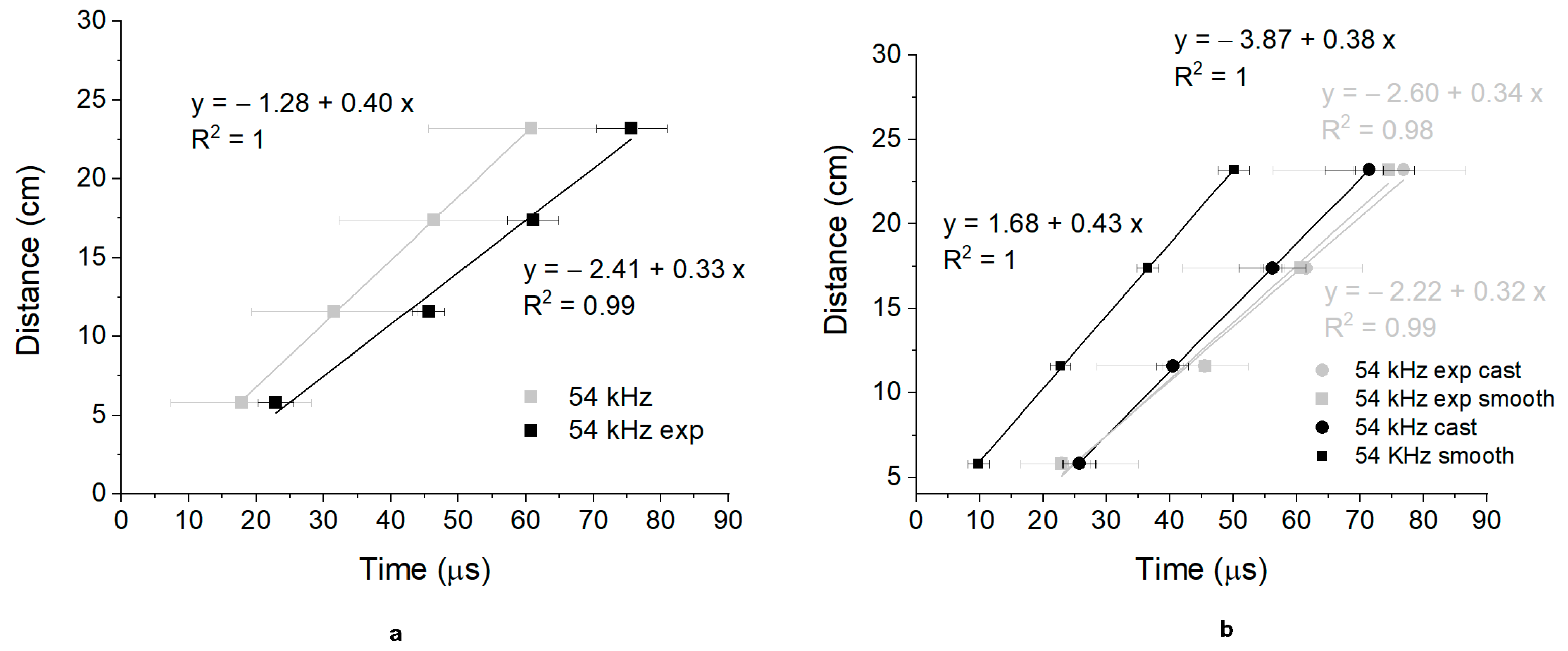
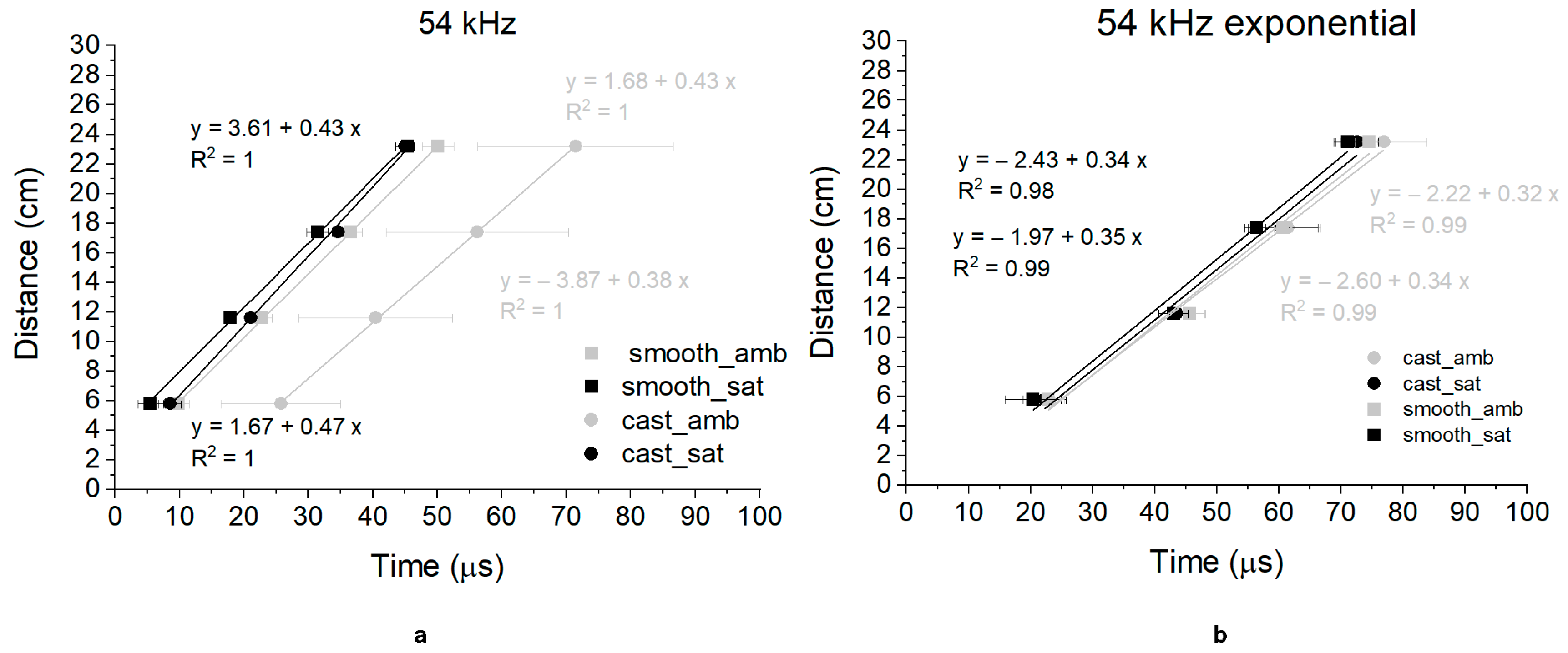
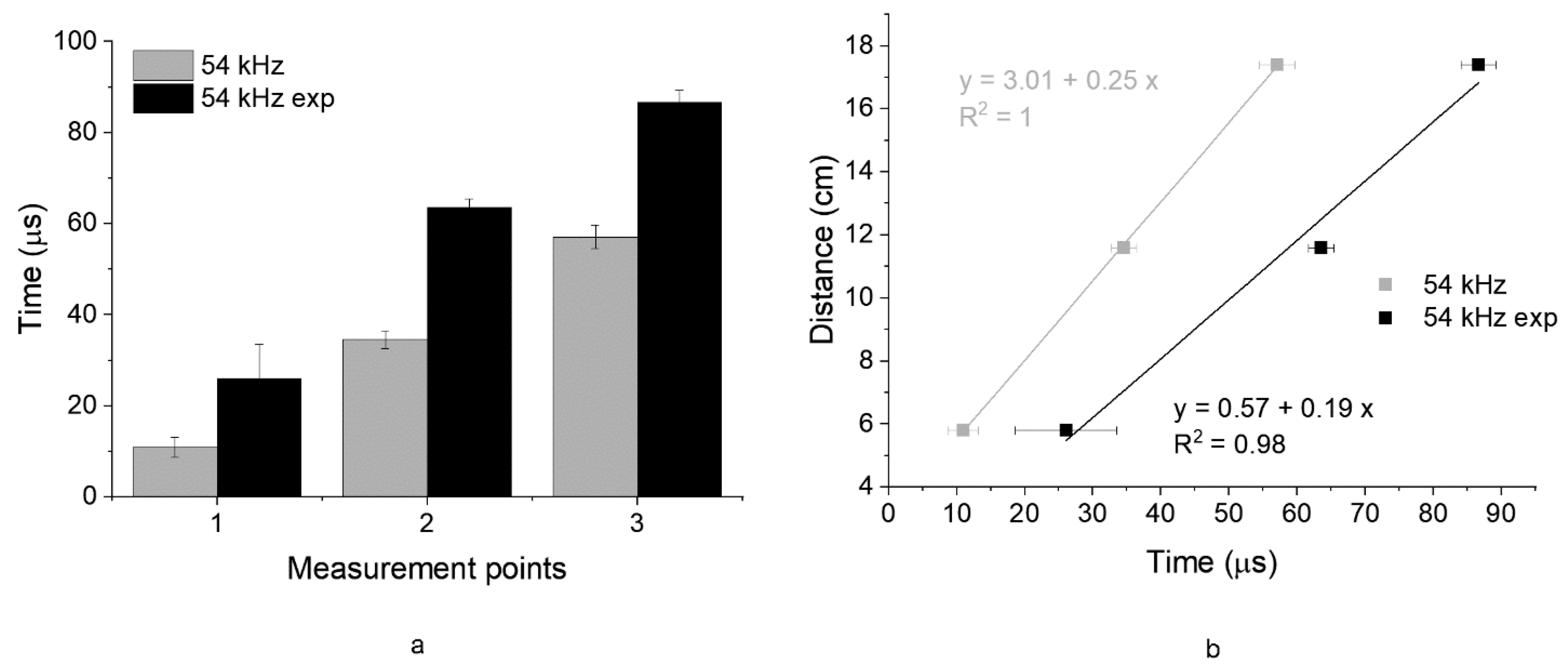

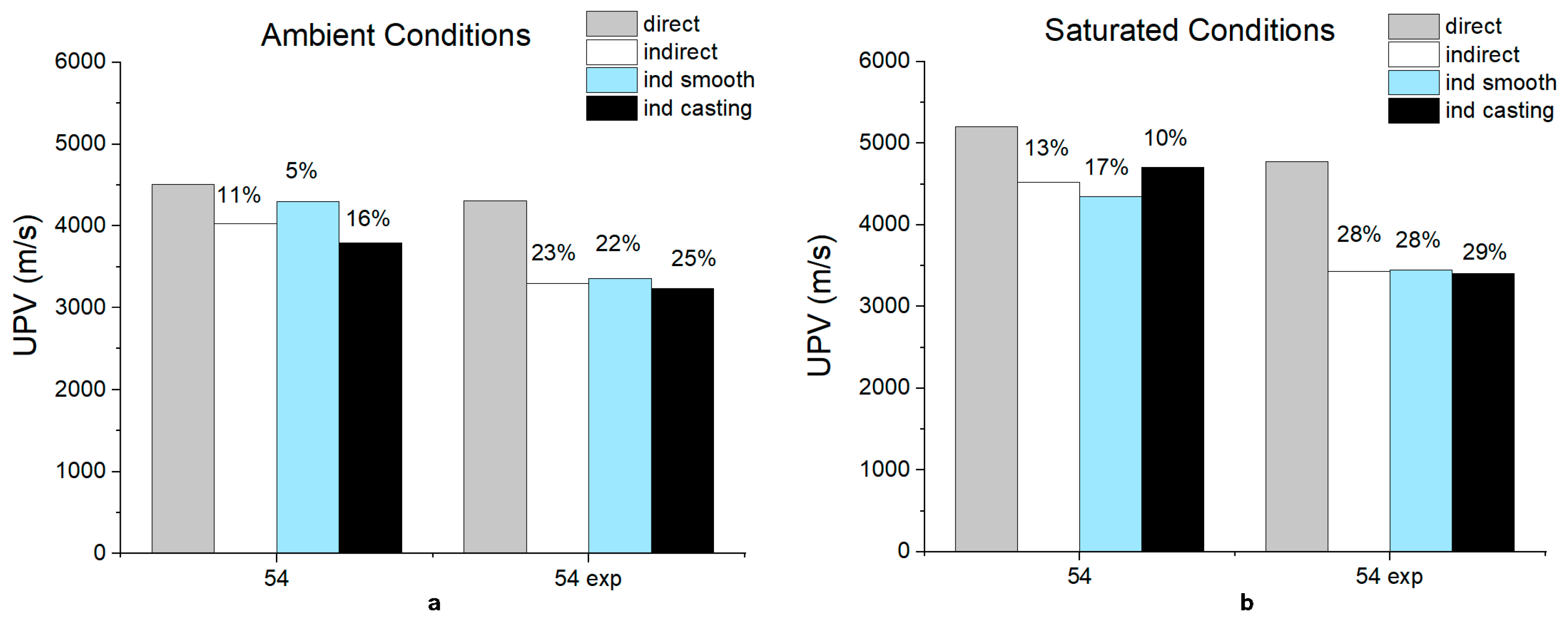
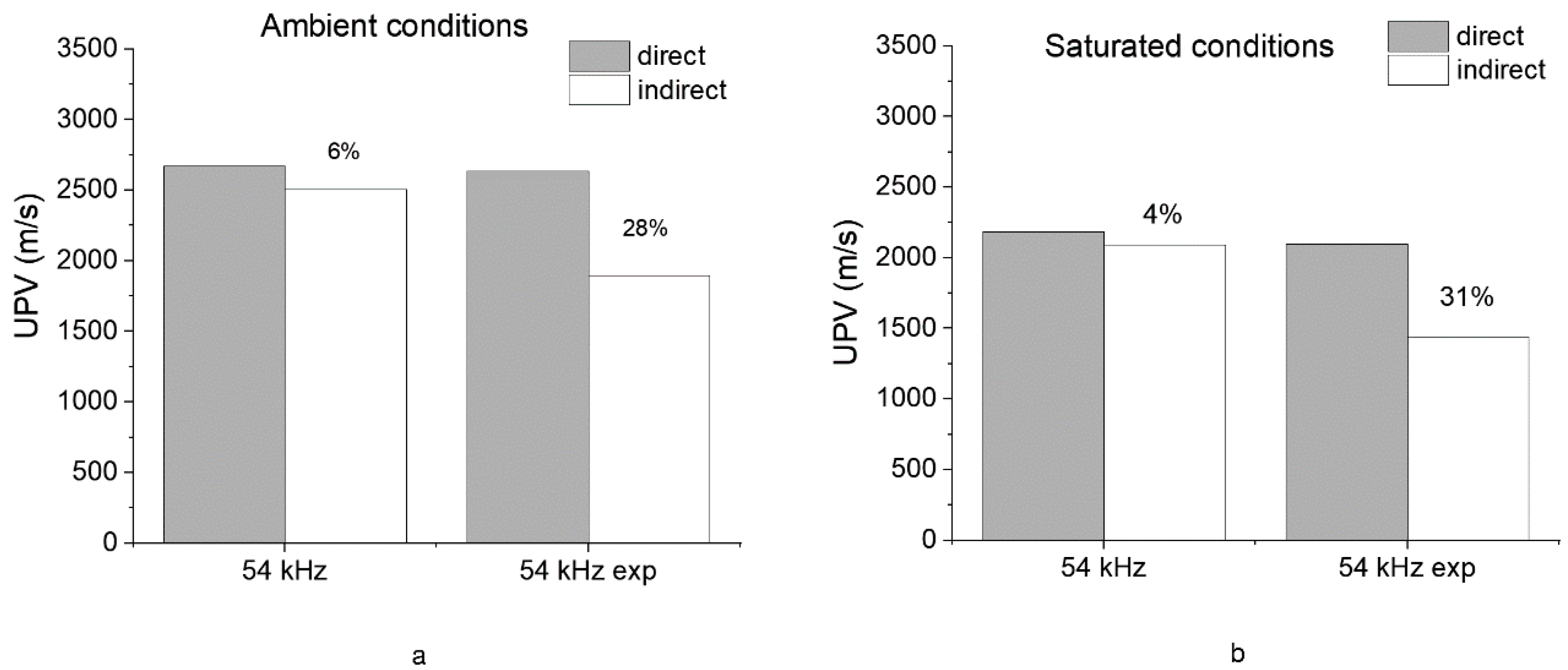
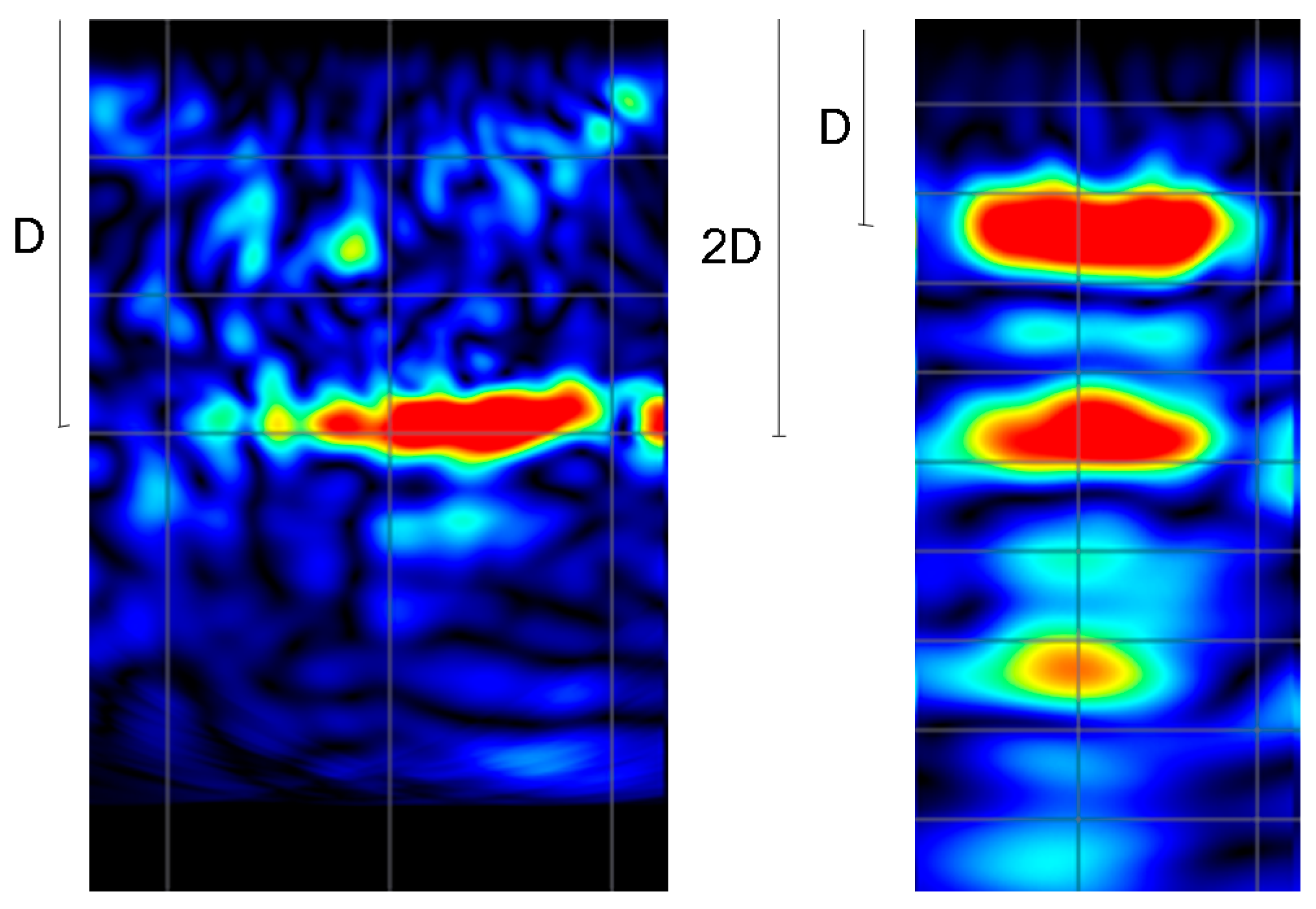

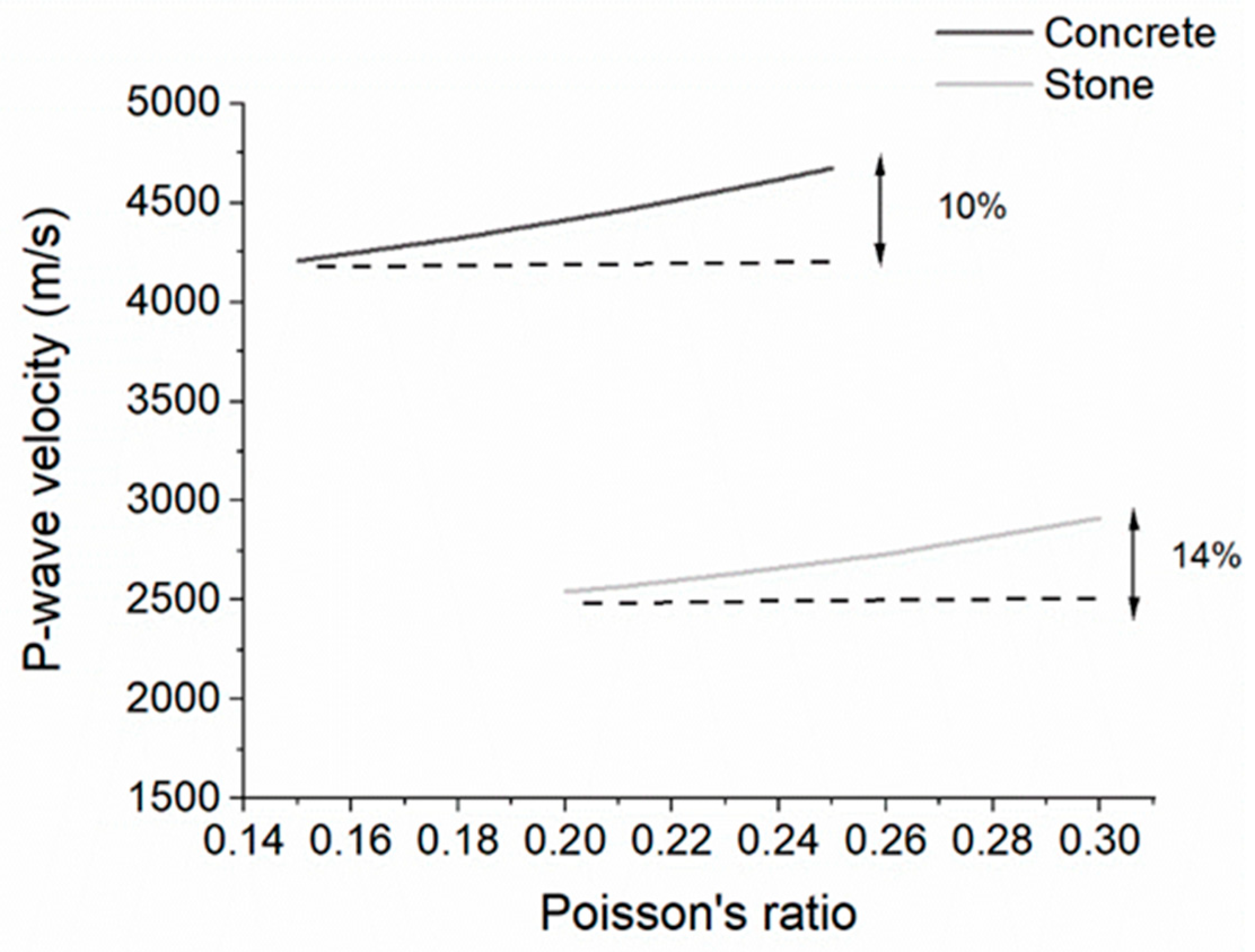
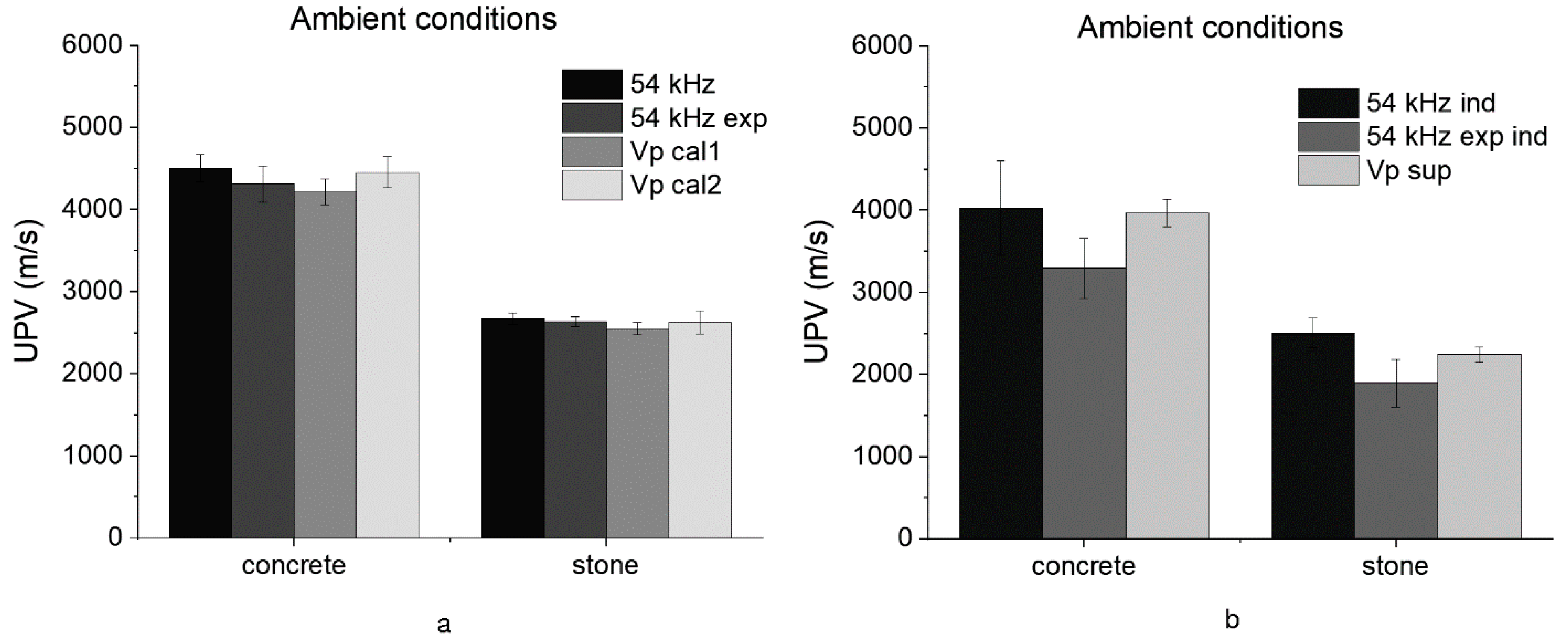
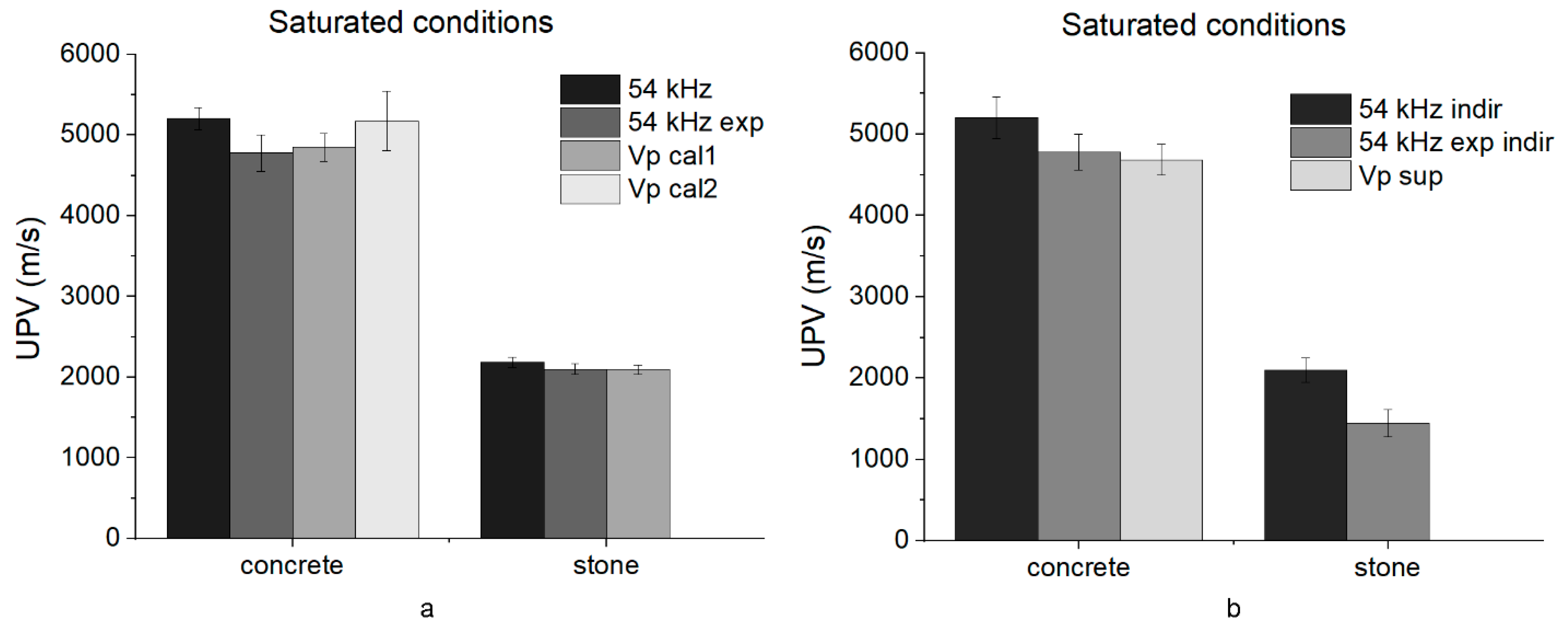
| Concrete Blocks Ambient | Concrete Blocks Saturated | Stone Blocks Ambient | Stone Block Saturated | |
|---|---|---|---|---|
| 54 kHz | 4510 (4%) | 5204 (3%) | 2671 (3%) | 2183 (3%) |
| 54k Hz exp | 4310 (5%) | 4777 (5%) | 2601 (2%) | 2100 (4%) |
| Δ (cyl-exp) | 4.4% | 8.2% | 2.6% | 3.9% |
| Concrete Blocks Ambient | Concrete Blocks Saturated | Stone Blocks Ambient | Stone Block Saturated | |
|---|---|---|---|---|
| 54 kHz | 4032 (14%) | 4523 (6%) | 2506 (7%) | 2091 (7%) |
| 54 kHz exp | 3297 (11%) | 3432 (6%) | 1893 (15%) | 1442 (11%) |
| Δ (cyl-exp) | 18% | 24% | 24% | 31% |
| Concrete Blocks Ambient | Stone Blocks Ambient | Concrete Blocks Saturated | Stone Blocks Saturated | |
|---|---|---|---|---|
| UPV difference (%) | ||||
| Sup-Cal 1 | −6 | −14 | −4 | - |
| Sup-Cal 2 | −12 | −17 | −10 | - |
| Cal 1-Cal 2 | −6 | −3 | −7 | - |
| CoV (%) | ||||
| Sup | 4 | 4 | 4 | - |
| Cal 1 | 4 | 4 | 3 | 3 |
| Cal 2 | 4 | 7 | 6 | |
| Concrete Blocks Ambient | |||||
| Cal 1 | Cal 2 | Sup | |||
| 54 kHz-Vp_cal1 | 7% | 54 kHz-Vp_cal2 | 1% | 54 kHz ind-Vps | 2% |
| 54 kHz exp-Vp_cal1 | 2% | 54 kHz exp-Vp_cal2 | −3% | 54 kHz exp ind-Vps | −20% |
| Stone Blocks Ambient | |||||
| Cal 1 | Cal 2 | Sup | |||
| 54 kHz-Vp_cal1 | 4% | 54 kHz-Vp_cal2 | 2% | 54 kHz ind-Vps | 10% |
| 54 kHz exp-Vp_cal1 | 3% | 54 kHz exp-Vp_cal2 | 0% | 54 kHz exp ind-Vps | −19% |
| Concrete Blocks Saturated | |||||
| Cal 1 | Cal 2 | Sup | |||
| 54 kHz-Vp_cal1 | 7% | 54 kHz-Vp_cal2 | 1% | 54 kHz ind-Vps | 2% |
| 54 kHz exp-Vp_cal1 | −1% | 54 kHz exp-Vp_cal2 | −8% | 54 kHz exp-Vps | −20% |
| Stone Blocks Saturated | |||||
| Cal 1 | Cal 2 | Sup | |||
| 54 kHz-Vp_cal1 | 2% | 54 kHz-Vp_cal2 | - | 54 kHz ind-Vps | - |
| 54 kHz exp-Vp_cal1 | −2% | 54 kHz exp-Vp_cal2 | - | 54 kHz exp-Vps | - |
Disclaimer/Publisher’s Note: The statements, opinions and data contained in all publications are solely those of the individual author(s) and contributor(s) and not of MDPI and/or the editor(s). MDPI and/or the editor(s) disclaim responsibility for any injury to people or property resulting from any ideas, methods, instructions or products referred to in the content. |
© 2025 by the authors. Licensee MDPI, Basel, Switzerland. This article is an open access article distributed under the terms and conditions of the Creative Commons Attribution (CC BY) license (https://creativecommons.org/licenses/by/4.0/).
Share and Cite
Vasanelli, E.; Di Gennaro, D.; Sticchi, M.; Blasi, G.; Capozzoli, L. Comparison of Pulse-Echo Tomography and Through-Transmission Ultrasonic Test for UPV Characterization of Building Materials. Infrastructures 2025, 10, 162. https://doi.org/10.3390/infrastructures10070162
Vasanelli E, Di Gennaro D, Sticchi M, Blasi G, Capozzoli L. Comparison of Pulse-Echo Tomography and Through-Transmission Ultrasonic Test for UPV Characterization of Building Materials. Infrastructures. 2025; 10(7):162. https://doi.org/10.3390/infrastructures10070162
Chicago/Turabian StyleVasanelli, Emilia, Davide Di Gennaro, Matteo Sticchi, Gianni Blasi, and Luigi Capozzoli. 2025. "Comparison of Pulse-Echo Tomography and Through-Transmission Ultrasonic Test for UPV Characterization of Building Materials" Infrastructures 10, no. 7: 162. https://doi.org/10.3390/infrastructures10070162
APA StyleVasanelli, E., Di Gennaro, D., Sticchi, M., Blasi, G., & Capozzoli, L. (2025). Comparison of Pulse-Echo Tomography and Through-Transmission Ultrasonic Test for UPV Characterization of Building Materials. Infrastructures, 10(7), 162. https://doi.org/10.3390/infrastructures10070162









